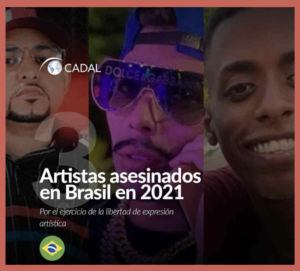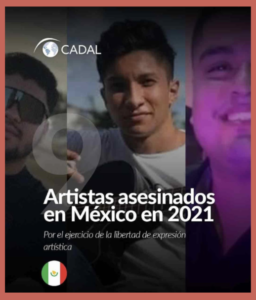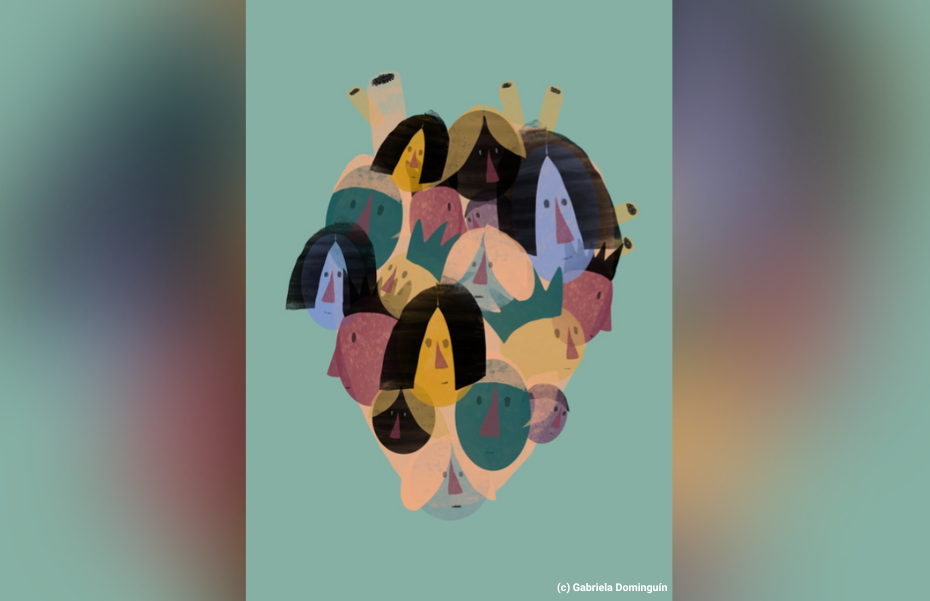Welcome to this blog entry about Latin America! I am Diana, and during the times I have worked with vulnerable communities in my country Colombia, art has allowed me to enter into dialogue about inequality, conflict, memory, and territorial retribution in a country where violence and drug trafficking have marked each of our lives as Colombians directly or indirectly.
On the other hand, working with artivists from authoritarian contexts such as Cuba, Venezuela, and Nicaragua, as well as working with artists at risk in the region, has allowed me to see how art is a tool that can spark dialogue on issues such as freedom of expression, political change, civic space, and the defence of human rights.

I work in the field of artistic freedom in the region because I firmly believe that the vibrancy of artistic creation is essential in developing dynamic cultures and contributes to promoting democratic values. Artistic expression is integral to a rich cultural life as it challenges inherited meanings, ideas, and concepts and helps societies evolve. Artists, like journalists and human rights defenders, are at particular risk when their work publicly critiques social and cultural norms or political ideas. In Latin America, artists are also at risk due to economic vulnerability, social conflicts, and violence resulting from drug trafficking and cartel wars. Since I lived through those same social conditions, my colleague Cecilia Noce and I set out to research the violence that artists suffered.
During the research conducted within the project of Artistic Freedom Defense in CADAL in 2021, we recorded 378 attacks on freedom of artistic expression, of which 23 were cases of artists killed in four countries. The highest numbers of targeted killings were documented in Mexico (9 artists), Colombia (10 artists), and Brazil (3 artists). The attacks took place in a broader context in which there was rampant violence due to organised crime and drug trafficking that impacted the general population, including civil society members. Of the cases recorded, 21 were young male musicians from marginalised areas and impoverished communities, 3 of whom were recognized as social and cultural activists in their communities.

We see that these human rights violations are intended mainly to intimidate civil society organisations active in the areas where artists work in contexts with the presence of organised crime groups, making them particularly vulnerable to armed gang violence. On the other hand, the nature of their work increases their susceptibility to attacks in violence-prone regions. This includes their working conditions in which they often operate alone, within largely informal and un-unionized sector working hours, which often extend into the night, and precarious routes to work.
The monitoring in 2021 also showed that artists were killed just before, during, or at the end of a performance, exhibition, show, or concert. This includes those killed on stage or while entering or leaving the premises where their shows were hosted and visual artists killed while attending their exhibitions. In the case of activists/artists renowned for their artistic commentary on social issues, the monitoring showed that most of them were social leaders who utilised rap as a tool to challenge the ongoing violence by armed groups or were cultural leaders of indigenous communities.
Something that worried us the most was not just the fact that artists were killed while they were exercising their right to peaceful assembly, but that two of the 23 cases involved security forces. In Colombia, Nicolás Guerrero, known in the graffiti world as ‘Flex,’ was killed by a bullet while participating in the social protests of May 2 in Cali, a Colombian city located in the department of Valle del Cauca. His murder was recorded through a cell phone camera by artist DJ Juan de León, who broadcast the protests live through his social networks and subsequently received death threats that forced him to leave the city temporarily.

The remaining 21 documented cases were the result of violence related to drug trafficking in which there are three clear trends:
The first group of artists were executed for being activists or social leaders who used music as a vehicle for self-expression and activism. Through their lyrics, they denounced the current situation in their territories. This is the case of the murders of Julián Sneider Múñoz, Junior Jein, Esnaider Javier Castillo, and the indigenous leader Rafael Domicó Carupia.
A second group is related to artists who directly relate to cartels or criminal organisations and can often be caught up in retaliatory attacks. This is the case of narcocorrido singers in Mexico, who are recruited by cartels and therefore become targets in the drug trafficking wars. A similar phenomenon happens in Brazil with “forró or carioca” funk artists [1] whose careers are built under the protection and patronage of a specific criminal group. Attempts to leave the circuit or to perform in the “territories” of other cartels can lead to threats and attacks, which can be fatal.
A third group is related to artists killed by drug traffickers as a way of generating terror and establishing their authority over civil society when they take over territory. In 2021, in Oaxaca, a state in southern Mexico six young musicians were abducted and executed after three weeks when armed groups linked to drug cartels tried to take control of drug trafficking in the area. In Brazil, percussionist Renato Santos Evangelista Sobrinho was kidnapped after performing in the city of Camaçari, in the state of Bahia located in northeastern Brazil, and brutally executed.
All these generate repudiation and deep pain because the killings of artists are mostly unnoticed, as violence and the losses it creates are something Latin American societies, unfortunately, have to live with daily. Nonetheless, the killing of artists due to their exercise of their right to freedom of expression is an alarming situation that we need to attend to, document, and denounce.
The monitoring results can be found in Spanish here, and an executive summary in English is available here.
Authors: Cecilia Noce and Diana Arévalo
Cecilia Noce is the Coordinator of CADAL’s Project “Defense of Freedom of Artistic Expression.” Researcher specialised in Freedom of Artistic Expression and Human Rights. UNESCO expert for Latin America in the Aschberg Program. Master in Sociology of Culture and Cultural Analysis, Instituto de Altos Estudios Sociales, National University of San Martín, Argentina- Year 2014.
Diana Arévalo is CADAL’s Consultant in the Project “Defense of Freedom of Artistic Expression.” Master in International Studies at Universidad del CEMA, Buenos Aires. Specialist in Cultural Management and Communication at FLACSO, Buenos Aires. Professional in Government and International Relations at Universidad Externado de Colombia.
Notes
About forró music: It is a musical genre, a rhythm, and a dance, as well as the event itself in which forró music is played and danced, which originated in the northeastern region of Brazil. It encompasses several types of dance and musical genres.
The image has the faces of 3 of the artists killed in Brazil, as part of CADAL´s campaign to remember who they were.
The image has the faces 3 of the artists killed in México, as part of CADAL´s campaign to remember who they were.
The image has the faces of 4 of the artists killed in Colombia, as part of CADAL´s campaign to remember who they were.
- Title Image – (c) Gabriela Dominguín (Licence)

